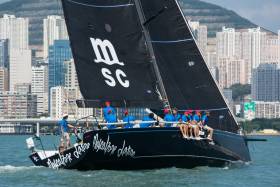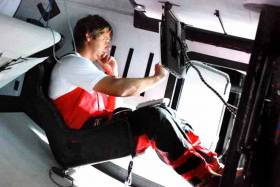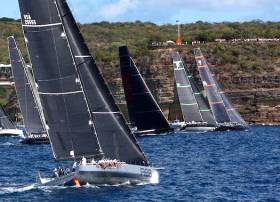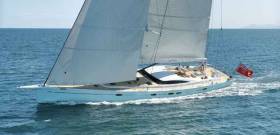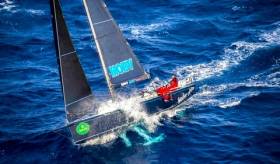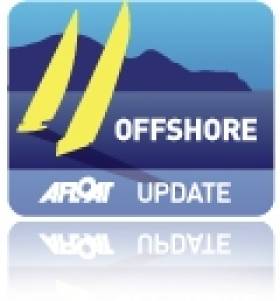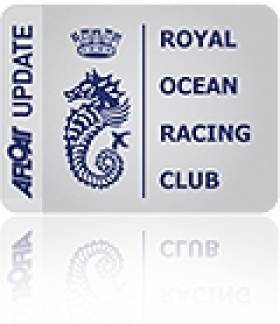Displaying items by tag: Ian Moore
One big overall win has eluded Northern Ireland navigator Ian Moore - in nine attempts at the Rolex Fastnet Race Moore’s team has made the podium twice but failed to win the Royal Ocean Racing Club’s flagship race. Ian is fascinated by the Fastnet Race and is a leading expert on offshore racing tactics and strategy. He analyses the new route, giving expert advice on the nuances of the famous offshore classic scheduled to start on August 8th, 2021.
Moore hails from Carrickfergus but has lived in Cowes, Isle of Wight for many years.
As a navigator, Ian has a highly impressive record with big event wins literally running off the page: Volvo Ocean Race, Transatlantic Race, Rolex Sydney Hobart, Newport Bermuda Race, RORC Caribbean 600, Transpac, Rolex Middle Sea Race, Rolex Giraglia, HK Vietnam Race, and Round Ireland.
The live interview (below) with Louay Habib include stories, pictures and the 2021 Rolex Fastnet course.
Northern Ireland Sailor Ian Moore Navigates a Mighty Win in Hong Kong-Vietnam Race
Having Saturday’s Rolex Middle Sea Race start from Malta without the presence of 2016 winner Mascalzone Latino, the Cookson 50 owned by Vincenzo Onorato and navigated by Ian Moore, is a bit like staging Hamlet without the Prince writes W M Nixon.
But the reigning champion – which has also been ORC World Champion in recent years - is already well into a completely new campaign towards the Rolex Sydney-Hobart Race 2017, and it has been confirmed this afternoon that the Mascalzone team have seen their wide-ranging programme towards Sydney off to a flying start with a mighty win in the 673-mile Hong Kong to Vietnam Race, their qualifier to take part in the often rugged sprint to Hobart.
Admittedly there were just 13 boats in the Vietnam race. But as one of them was significant sister-ship Ubox, the Cookson 50 that finished third overall in IRC and first in ORC in the Sydney-Hobart 2016, the Mascalzone crew had a useful marker to speed them towards Vietnam in a swift and rugged race. It was something like 95% offwind. and initially warm and wet with spray and then hot and wet as they closed in on the finish, after 2 days 5 hours and 25 minutes.
They were third on line honours and soon confirmed as first overall on IRC. And they did a horizon job on Ubox. After the Reichel Pugh 63 Lucky was navigated by Ian Moore to an exceptional win in the 2015 Transatlantic Race, the crew said that having “Soapy” Moore calling the shots was as good as knocking at least 150 miles off the distance to be race. Well, in the much shorter Hong Kong to Vietnam Race, Ubox was all of 120 miles astern as Mascalzone Latino finished……
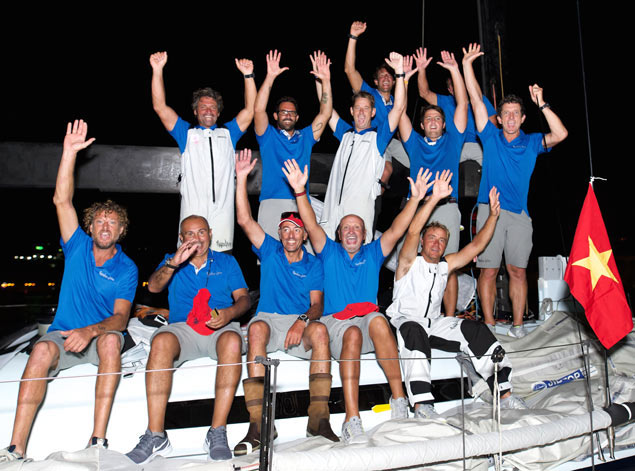 Night finish. The winning crew at Nha Trang in Vietnam, Ian Moore in middle of second row
Night finish. The winning crew at Nha Trang in Vietnam, Ian Moore in middle of second row
The winning crew were Vincenzo Onorato, Adrian Stead, Ian Moore, Lorenzo Bressani, Flavio Favini, Leonardo Chiarugi, Matteo Savelli, Gaetano Figlia di Granara, Stefano Ciampalini, Pietro Manunta, Davide Scarpa and Justin Clougher.
Some you’ll know, some you won’t, but of particular interest is that last name, Justin Clougher. His family may well be from Tyrone way back, but he’s from Tasmania and is a full-time racing sailor now based in Newport, RI with enormous offshore experience including many Sydney-Hobarts. That he is included in Mascalzone’s crew in their buildup towards Sydney is indicative of the care that is going into planning and implementing this impressive campaign.
Northern Ireland Sailor Ian Moore Sets Course for Vietnam
Ian Moore, originally of Carrickfergus, and Afloat.ie “Sailor of the Month” in October 2016 after navigating the Italian Cookson 50 Mascalzone Latino to overall victory in the Rolex Middle Sea Race last year, is not defending his Middle Sea title this time round writes W M Nixon. When the 2017 edition gets under way from Malta in Grand Harbour, Valetta on Saturday, Moore will be in the Far Eastern waters in Vietnam, for this morning he started in the biennial 690-mile Hong Kong to Vietnam Race.
For this one, he’s again navigating Mascalzone Latino, but with a new owner. The Middle Sea Race winning owner was listed as Vincenzo Onorato, but in the current race the boat sails under the colours of Matteo Savelli.
The fleet is modest – just 13 competitors after more than 40 took part in the recent regatta series in Hong Kong - and Mascalzone is racing in a group of ten, as the three lowest-rated boats were sent on their way yesterday. However, there are some notable contenders, and doing the race is part of the buildup in the bigger plan, as it counts as qualifier for the Rolex Sydney-Hobart Race 2017 on December 26th.
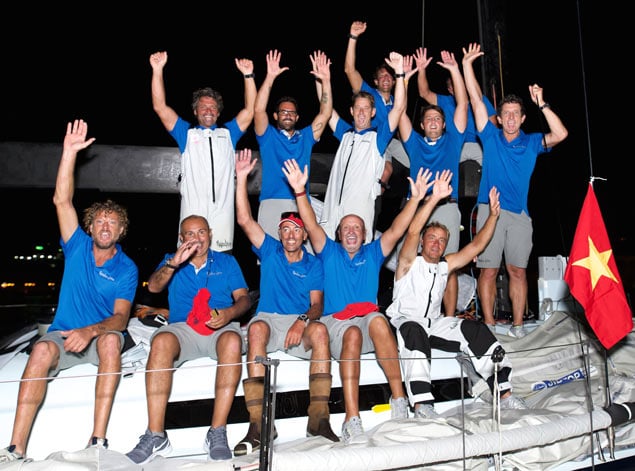 The Cookson 50 Mascalzone Latino, navigated by Ian Moore, on her way to overall victory in the Rolex Middle Sea Race 2016. The boat – navigated again by Moore – is currently contesting the Hong Kong to Vietnam Race as part of a buildup to the Rolex Sydney-Hobart Race 2017 on December 26th
The Cookson 50 Mascalzone Latino, navigated by Ian Moore, on her way to overall victory in the Rolex Middle Sea Race 2016. The boat – navigated again by Moore – is currently contesting the Hong Kong to Vietnam Race as part of a buildup to the Rolex Sydney-Hobart Race 2017 on December 26th
In that, there’ll be several Cookson 50s to sharpen up Mascalzone Latino’s performance to an even higher level. When we remember that the preliminary outlines of the Cookson 50 concept were first aired by Mike Cookson to Farr Yacht Design something like 14 years ago, and that one of them – Ron O’Hanley’s Privateer – was a close second in last year’s Fastnet while Ger O’Rourke’s sister-ship Chieftain was overall winner in 2007, then clearly “Flash in the Pan” simply wouldn’t do as the name for a Cookson 50.
Race tracker here
It is already being celebrated as “The Race of the Year”, even though 2017 is barely two months old. But it is difficult to visualise any forthcoming contest that will quite match the 600-miles-plus ding-dong that was the battle for the win in the RORC Caribbean 600 in February. Two of the most potent racing monohulls currently on the world scene, the Maxi 72s Proteus and Bella Mente, ended up in a red-hot race of their own that made the rest of the splendid fleet seem almost an irrelevance.
Not only was it two great boats in perfect tune, but the crew lineup on both was world class through and through. Ireland had sent of her very best, as Gordon Maguire was on the strength in Proteus, while Ian Moore was sailing as navigator/tactician on Bella Mente.
Threading your way through the Caribbean 600’s unique multi-island course results in a track chart which looks like the preliminary sketches for a bulimic Dalek. Thus the navigator/tactician’s already important role becomes even more significant. But as they closed towards the finish and Ian Moore’s positioning of Bella Mente showed he’d made the win move, the destination of the Afloat.ie “Sailor of the Month (Racing)” award for February 2017 became indisputably clear-cut.
Irish Sailors Still Well Up in RORC Caribbean 600 Mix
Maybe it’s because the weather has been unseasonably like home at times out in the Caribbean, but the Irish sailors spread through the RORC fleet have been in the racing frame through a wet cold front from the nor’west. For a while, it turned sunshine hopes upside down, but the Micks in the mix are on boats which have been showing mighty well since last’s night’s posting, when top navigator Ian Moore on Bella Mente was leading the fleet on IRC writes W M Nixon.
The first of the multi-hulls, Lloyd Thornburg’s MOD 70 Phaedo 3 with Damian Foxall on the strength, has already taken line honours in 33 hours. But further down the line, the pendulum of fortune has swung back and forth as monohull boats of hugely varying sizes take on the challenges of a real cat’s cradle of a course.
The vagaries of fortune are revealed by the fact that for some hours this morning Irish time, the overall leader was the superyacht Dannesskjold, whose crew include Tim Goodbody, Aine Hanevy, and Paul O’Donoghue, while the Kinsale-registered Lilla was third. But the most recent set of figures show that Dannesskjold has plunged to 32nd overall, while Lilla plunhed to 48th, and the best-placed Irish sailor is now Marcus Spillane, originally of Cork, now San Francisco-based, an ISA Board Member and representative on World Sailing.
He also presides over the 49er International Association and the Nacra 17 Association, but currently his focus is on getting the best performance out of the Swan 66 Bounty in the Caribbean 600, and they lie third overall, 20 minutes or so ahead of George David’s Rambler 88 in fourth, and 45 minutes ahead of Bella Mente in 5th. Yet while Phaedo may be well finished, but there’ll be many twists of failure and fortune before we get the final IRC placings.
Ian Moore Is 'Sailor of the Month (Offshore)” for October
Ace navigator and tactician Ian Moore, originally of Carrickfergus but long based in Cowes, is first choice as navigator/tactician for any serious international offshore campaign. Last year, he guided the RP 63 Lucky for a stunning win in the Transatlantic Race, and was also calling the shots on the Maxi 72 overall Champion after playing a key role in Bella Mente’s domination of Cowes Week.
The only fly in the perfection of 2015’s ointment was losing the overall win in the Rolex Middle Sea Race with Vincenzo Onorato’s Cookson 50 Latino Mascalzone by just nine seconds. But all that was put right at the end of October 2016 in Valetta, when Latino Mascalzone was declared overall winner of the Rolex Middle Sea Race 2016 by a very handsome margin.
And it was a classic Moore success. Mascalzone Latino’s crew knew that at a crucial stage of the race, a 50 degree windshift was approaching. The Moore speciality is in placing the boat in the best possible position to maximize advantage from any new wind direction, and this year’s Middle Sea Race provided him with the opportunity to give a masterclass in hitting the change spot on.
In all, it was a great race for those old warhorses the Cookson 50s, as another one was tops in ORC. And Irish sailors had a good time of it too, with ex-Pat Barry Hurley of the RIYC and Kenneth Rumball of the Irish National Sailing School crewing on the XP 44 Xp-Act, which came second in Class 4. But as the bubbles settle and the Rolex Middle Sea Race 2016 gets the full analysis from the number crunchers, it is Ian Mooore’s calling of the shots on Latino Mascalzone which clearly makes him the Afloat.ie “Sailor of the Month (Offshore) for October.
 Ian Moore of Carrickfergus is among the top navigators in the world
Ian Moore of Carrickfergus is among the top navigators in the world
Last night produced one of the most dramatic finishes in the history of the Rolex Middle Sea Race and it had an Irish dimension thanks to the presence of Carrickfergus navigator Ian Moore. Two yachts finished within sight of each other vying for the overall win in IRC for the Rolex Middle Sea Race Trophy after over 600 miles of intense racing.
Michele Galli's TP52, B2, crossed the finish line outside the Royal Malta Yacht Club just before midnight, to take first position in the overall rankings but there was a nervous look about the crew. They scanned the darkness outside Marsamxett Harbour, looking for the masthead light of Vincenzo Onorato's, Cookson 50, Mascalzone Latino. As their Italian rivals came into view, the tension was obvious on board B2. Mascalzone Latino crossed the finish line just after midnight and stopped the clock. After three and half days and nights at sea, B2 corrected out to beat Mascalzone Latino by an astonishing seven seconds.
Michele Galli's TP52, B2 is now the provisional overall leader of the IRC fleet, vying for the Rolex Middle Sea Race Trophy. The vast majority of the fleet are still racing but it is most likely that the corrected time, set by B2, will not be bettered.
Mascalzone Latino's navigator, Ian Moore, was obviously disappointed with the result but upbeat about the performance of the team.
“This is the first time we have sailed together as a team for over a year and we put in a great performance, so we can be happy with that but to be beaten by such a small margin is never nice.” commented Ian Moore. “Our team and the boat performed well over a broad range of conditions, and we especially made big gains in the light winds. B2 was always going to be quicker than us in a straight line and they did well in the transition zones at Stromboli and Capo San Vito. We did catch up 14 miles on the first night going past Mount Etna, which was a big gain for us. On the leg from Lampedusa to the finish, there were a lot of thunderstorms and we saw one wind shift of 50 degrees, which we got spot on. Of course there were lots of occasions we could think about where we could have gained those precious seconds but this was an exciting race for us and tactically extremely difficult.”
In IRC Three, the leaders have made a clean getaway from the rest of the pack with the Turkish team racing Ker 40, Arkas Flying Box, leading on the water and on corrected time from Bastiaan de Voogd's Dutch Sydney 43, Coin Coin. Vittorio Biscarini's Italian team racing Ars Una are lying third. The trio are passing Lampedusa, with approximately 100 miles to go and are expected at the Royal Malta Yacht Club tonight.
In IRC Four at Favignana, Chris Opielok's Corby 36, Rockall IV, was leading after time correction. Just three minutes behind the leader was Sonke Stein & David Anastasi’s, Maltese J/133,Oil Tanking Juno. By Pantalleria, Christoph Podesta's Maltese First 45, Elusive II BOV had over taken both yachts on time correction to take up the running.
In IRC Five at Favignana, Lee Satariano & Christian Ripard's Maltese J/122, Artie held a narrow lead of just 16 minutes on corrected time from Laurant Charmy's French J/111, SL Energies Groupe Fastwave. However by the time the leaders passed Pantalleria, Costantin Manuele's First 40.7 Canevel Spumanti had over taken both yachts after time correction.
In IRC Six, Milan Hajek's Czech Republic Team, racing First 40.7, Three Sisters holds a commanding lead over Peppe Fornich Italian Grand Soleil 37, Sagola-Biotrading and Gherardo Maviglia's Amapola.
To follow the race, visit the official Rolex Middle Sea Race web site.
All of the competitors are encouraged to contact the media team during the race with stories from the sea, pictures and even videos.
All of the competing yachts are fitted with YB trackers showing their position and other telemetric data.
Conditions About to Change in The Middle Sea Race
Carrickfergus sailor Ian Moore, navigator on Vincenzo Onorato's Cookson 50 Mascalzone Latino, reported feeling mixed emotions on board this afternoon in the second day of the Middle Sea race. “Just having a cold beer and some antipasti to celebrate getting out of the Straits but need an anti-depressant having seen the Ireland score!” (Ian's is referring to Ireland losing to Argentina in the Q-T of the Rugby World Cup.)
So far the Rolex Middle Sea Race has produced conditions which have favoured the smaller yachts but that is about to change. The fleet caught in Messina have little wind and experiencing foul current. For now, as a guide only, leading yachts from IRC Classes 5 and 6 include; Lee Satariano and Christian Ripard's J/122 Artie, Costantin Manuele's First 40.7, Canevel Spumanti and Vikesha II skippered by Oleg Evdokimenko. However, expect the high performance yachts to get back up the rankings by tomorrow afternoon.
Lloyd Thornburg's MOD 70 Phaedo3 passed through Messina Strait, approximately 24 hours into the Rolex Middle Sea Race and rounded Stromboli at approximately 1600 CET. The ballistic trimaran is expected to get into fresh breeze from the southeast during this evening. The three combined hulls of Phaedo3 have a waterline length of 60 metres (200ft) but the entire structure only weighs 7000kg. Coupled with hi-tech sails and a rotating and canting mast, Phaedo3 is capable of travelling at over twice the wind speed. Later tonight, Phaedo3 is expected to be on a broad reach in 15 knots of breeze and should be literally flying at well over 20 knots of boat speed, towards the most northwesterly point of the course, Favignana. It is highly unlikely that any of the 111 strong fleet will see Phaedo3 again, until they return to Malta.
George David's American Maxi Rambler 88 is in a commanding position to take monohull Line Honours having stretched out a 15-mile lead over Jan-Henrik Kisteit's German Maxi 72, Momo. At 1600 CET, only eight yachts had passed through the Messina Strait: Rambler 88, Momo, Mascalzone Latino,B2, Wild Joe, Varuna, Plis Play and SFS II. This pack of yachts is very likely to pull away from the fleet left in the Messina Strait, especially as the vast majority of the fleet are now experiencing negative current and will do so for the next few hours.
#offshore – The Reichel-Pugh 63 Loki, which started life in 2009 under Stephen Ainsworth's ownership racing to many wins out of Sydney in the top Australian offshore classics, has continued her successful career under her new name of Lucky and the ownership of American Bryon Ehrhart writes W M Nixon.
In the Ainsworth ownership, Loki was under the command of Gordon Maguire, originally of Howth. For three years , she was clear ahead as top Australian boat, winning the Rolex Sydney-Hobart Race of 2011, and coming second overall and winning her class in the 2012 race, in addition to achieving other successes including many combined line honours/overall wins in the busy Australian offshore programme along the east coast and north towards the resort ports of the Great Barrier Reef.
Stephen Ainsworth had always said he would give racing at this level his undivided attention for five years, and then he'd exit the scene. He did that very thing, so for a couple of years now Gordon Maguire has been skipper for Matt Allen on the Carkeek 60 Ichi Ban. As for Loki, naturally potential Australian owners were a bit wary of taking on such a comprehensive winner, as they'd have no excuse for not continuing her success. So the feeling was that she'd be sold away, and now she is in the hands of Bryon Ehrhart who has re-named her Lucky, which is pretty much what her name meant in Norwegian anyway.
Though Chicago-based, Erhart is in the thick of things in big boat racing on America's east coast focused on the New York YC's base in Newport Rhode Island at Harbour Court. The NYYC is very much involved in this month's Royal Yacht Squadron Bicentennial Celebrations staged from Cowes, and is one of the organisers in the current Transatlantic Race towards the Squadron celebrations, a marathon - started from Newport - which has been experiencing some distinctly rough but fast conditions. The fleet has been given three separate starts to take account of potential speed differences, the theory being that it should compress the finishing times to make the organizing of post-race events more manageable and meaningful, while also opening the field for more boats to hope to claim the line honours title.
From the time her division started, Lucky has been very much in the frame, and when she took that coveted line honours slot on Friday evening at the Lizard Point finish line after a "brutal" 8 days 22 hours 5 minutes and three seconds completion of the 2,800 mile course, her owner-skipper and crew were lavish in their praise for the routing techniques and weather-reading skills of their navigator, Ian "Soapy" Moore, who hails from Carrickfergus, but is Cowes-based these days as a navigator/tactician of international repute.
Moore's calls saved Lucky many miles at significant stages, and then at the end as they ran into the softer winds towards southwest England, he kept them on track to maintain a 37-mile lead over their closest challenge, a hundred footer. In Australian waters with that bit of Irish luck thrown in, Loki was lucky. In the North Atlantic, with some more Irish talent in the mix, Lucky was loki.
Currently she also holds the IRC Corrected Time lead in the Transatlantic, and looks likely to retain it against serious biggies such as the Kenny Read-skipper hundred footer Comanche, and George David's new Rambler 88, which started later and haven't "enjoyed" so much in the way of strong winds.
So Bryon Ehrhart's Lucky-ex-Loki will be seen as a sensible all-round good bet for the 90th Anniversary Fastnet Race on August 16th. She's certainly there in the official entry list of 387 boats, right there next to Liam Coyne's First 36.7 Lula Belle, which last year cut a real dash by winning the two-handed division in the RORC Round Britain & Ireland Race, with Liam sailing with Brian Flahive to a success which included the bonus of an outright win of two fully-crewed divisions. Nevertheless, with all due respect to Lula Bell's crew, being next to her on the entry list is just about as close as they'll get to the all-conquering Lucky in the Fastnet Race 2015.
Strong Winds Launch Caribbean 600
As if by magic, the tradewinds blew into the starting area off English Harbour, Antigua after several days of light winds. With 22 knots or more in the gusts. The strong winds launched the RORC Caribbean 600 fleet into action for the start of what is probably the world's most exciting 600-mile offshore race.
First off were the smaller boats, but powerful yachts by any normal standard. Piet Vroon's electric blue Ker 46, Tonnerre de Breskens, seared through the line on port like a guided missile. The Army Association's A 40, British Soldier sprang into action, stealing a march on the competition in IRC Two. Whilst, Tony Lawson's Class 40, Concise nailed the middle of the line to lead their class.
Ten minutes later, the line off Fort Charlotte was festooned with canvas. The 155ft Schooner Windrose of Amsterdam, chartered by Andrew McIrvine, came in on port at the pin end with amazing power; Peter Harrison's Farr 114, Sojana opted for a middle of the line start and engaged Brian Benjamin's Carbon Ocean 82, Aegir, (with Belfast's Ian Moore onboard) who were right in under the Pillars of Hercules. Sojana then tacked into Windrose's path, but thankfully there was no issue.
Whilst a battle royal was going on, Simonas Steponavicius' Volvo 60, Ambersail stole the line, taking a flyer on port. The Lithuanian team with veteran Swede Magnus Olsson on board, got away in clear air to lead their class at the start. No doubt, the amateur crew would have been welling up with pride and adrenalin, having pulled off the best start of the race.
Next up was the big showdown between the canting keelboats and there was drama even before the start. Inside the 10 minute gun, Hugo Stenbeck's Dubois 90 Genuine Risk, heard a sickening crack as the vang pulled clean out of its deck mounting: the team had no choice but to return to the dock.
Meanwhile, Mike Slade's ICAP Leopard and George David's Rambler 100 were getting on with big business. This is the first ever show down between two of the fastest boats in the world. ICAP Leopard came smoking in on port from course side, Rambler chose starboard under the cliffs. ICAP Leopard may have thought they were too early and tacked onto port, just before the line, whilst Rambler 100 wound up the canting keel flyer under the cliffs off Fort Charlotte. But it was Adrian Lee's Cookson 50, Lee Overlay Partners that judged the line to perfection. However, they were very quickly rolled by Rambler 100, who rounded Green Island in no time at all. Rambler 100 has pulled the trigger and power, sliding down the windward side of Antigua, at over 20 knots. A fire-hose of water will be smashing down the deck, as they smoke through the surf, barreling towards Barbuda.
Last to start were the multihulls. There may be only two of them this year, but that didn't stop Cam Lewis from match racing at the start on Lloyd Thornburg's Gunboat 66, Phaedo who turned Wonderful about in a pre-start dial up. The bright orange catamaran will be hotter than a pepper sprout when they turn downwind later in the day.
Heart-felt commiserations to Genuine Risk who are safely moored up in Antigua. They are missing out on a race which is already providing some ballistic sailing action. To quote Juggy Clougher, the veteran round the world sailor who is on Rambler 100: "Why wouldn't you want to do this race?"
Read John Burnie's expert analysis on the RORC Caribbean 600 website which contains regular updates on the race, blogs from the boats and follow the yachts on trackers:
http://caribbean600.rorc.org/race-information/tracking/2011-fleet-tracking.html



























